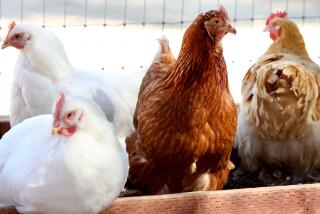A bloody lesson for backyard chicken enthusiasts
- Share via
Reporting from Columbia, Mo. — Fluffy, white broiler chickens pecked around the backyard while a group of two dozen people — a set of knives laid out before them — eyed them warily.
Jordan Dawdy, his arm bearing tattoos of chickens and other farm animals, gave the crowd the run-down: Snap the neck, cut off the head, drain the blood, pluck, gut, done. He has the whole process down to seven minutes.
The group shifted uneasily and prepared to dive in.
Dawdy’s “Yard to Skillet” workshops are booked full in this college town of 100,000. The local Center for Urban Agriculture launched them in August, several months after Columbia began allowing residents to raise hens within city limits.
Similar workshops are becoming popular around the country as a growing number of eco-conscious city dwellers are raising chickens for eggs and also have to learn how to sometimes cull — a nice way to say kill — their chickens. Classes are available in West Concord, Minn.; Southampton, N.J.; Livingston, Mont., and other places.
Dawdy, 33, tells his students to think of the workshop as a “meat garden.” The San Francisco native has slaughtered more than 1,000 chickens, most of them while working on a farm in Tennessee. Now he’s teaching the skill to other city folk.
Among them is Joe Fornioi, 48, who grew up in New York. He recently started raising hens for eggs in his Columbia backyard and is thinking ahead to the day when he’ll have to cull them.
“I’m doing it for the economy and for self-sufficiency,” said Fornioi, a gunsmith by trade and father of six.
Others at the workshop don’t have chickens yet but dream of raising them someday. Elizabeth Lameyer, a 23-year-old graphic artist, is considering returning to her roots by starting a small farm.
“My grandparents did this,” Lameyer said. “They didn’t want to teach me, but I want to know how to do it because my goal is to be totally sustainable.”
Workshops like this cater to consumers who want to eat locally and get close to their food. Dawdy said he’d seen many people at the workshops who, like himself, grew up in urban areas where meat usually never appeared outside a polystyrene package.
For his students, there was no fear of being too far removed from the process. They all emerged with blood on their clothes.
Dawdy started by showing his students how to scoop up a chicken and break its neck with an upward-backward jerk.
He hung the bird up by its feet, still flapping and twisting, and cut off the head to drain the blood. Dawdy said a chicken will run around with its head cut off, but it’s not a good idea to let it do that.
“You’d bruise the meat and break bones,” he explained.
Dawdy swished the now-limp bird around in a pot of hot water laced with detergent to loosen the feathers. After plucking, the chicken resembled any other pimply supermarket bird, except for the yellow feet still attached.
Next came evisceration. With a few cuts, the guts, liver and heart slid out easily. The lungs were trickier to remove. Dawdy had to scrape around with his fingers to pry out the bright pink blobs.
“A lot of times, they just get left in there,” he said. “Sometimes when you eat fried chicken and you’re like, ‘What’s that on the rib?’ That’s the lung.”
Finally, a few strokes of the knife, and off came the feet and neck. He rinsed off the bird and popped it in a cooler.
Dawdy looked around.
“So, who’s next?”
One by one, the others tried their hand.
“This is grosser than I thought,” Lameyer said, as she scooped her chicken’s guts onto the newspaper-covered table.
Across the yard, Jes Hodgson displayed her plucked, gutted bird to her boyfriend, Maxwell Philbrook.
“It was a bonding experience,” she said. “Now when I eat it, I’ll like it all the better.”
Hodgson and Philbrook planned to cook up a coconut chicken curry that evening. They said seeing the gore didn’t deter them from wanting to raise chickens.
“I still think it’s a good idea,” Philbrook said. “Then your food is fresh. You know what they’re eating, and you are what you eat.”
As the workshop wound down, the participants hosed their chickens clean and sealed them in plastic bags with ice water.
Those with stronger stomachs munched wedges of watermelon and sipped coffee as they finished up their first chicken culling.
Dou is a special correspondent.


